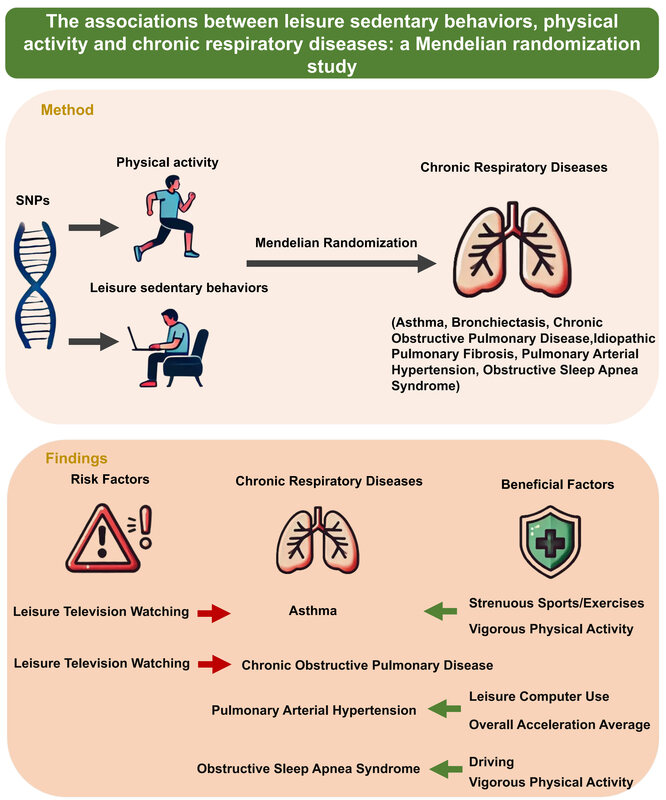Current issue
Archive
Manuscripts accepted
About the Journal
Editorial office
Editorial board
Section Editors
Abstracting and indexing
Subscription
Contact
Ethical standards and procedures
Most read articles
Instructions for authors
Article Processing Charge (APC)
Regulations of paying article processing charge (APC)
PULMONOLOGY / RESEARCH PAPER
The associations between leisure sedentary behaviors, physical activity and chronic respiratory diseases: a Mendelian randomization study
1
Department of Respiratory and Critical Care Medicine, Shanghai Ninth People's Hospital, Shanghai Jiao Tong University School of Medicine, China
These authors had equal contribution to this work
Submission date: 2024-11-06
Final revision date: 2025-03-02
Acceptance date: 2025-03-11
Online publication date: 2025-05-18
Corresponding author
huaqi guo
Department of Respiratory and Critical Care Medicine, Shanghai Ninth People's Hospital, Shanghai Jiao Tong University School of Medicine, Shanghai, China
Department of Respiratory and Critical Care Medicine, Shanghai Ninth People's Hospital, Shanghai Jiao Tong University School of Medicine, Shanghai, China
KEYWORDS
TOPICS
ABSTRACT
Introduction:
Chronic respiratory diseases represent a significant global health burden, characterized by high incidence and mortality rates. However, the potential link between physical activity, leisure sedentary behavior, and susceptibility to chronic respiratory diseases remain uncertain.
Material and methods:
A two-sample Mendelian randomization approach was used in this investigation, using physical activity and leisure sedentary behavior as exposures, and common chronic respiratory diseases such as asthma, bronchiectasis, chronic obstructive pulmonary disease, idiopathic pulmonary fibrosis, pulmonary arterial hypertension, and obstructive sleep apnea syndrome as outcomes, to explore the genetic causal relationships. We utilized genome-wide association studies to select genetic instrumental variables related to these exposures. These variables were then used to assess the impact of physical activity and leisure sedentary behavior on the susceptibility to chronic respiratory diseases.
Results:
Our findings indicate that strenuous sports or other exercises and vigorous physical activity are protective factors against asthma, whereas leisure television watching is a risk factor. Frequent leisure Television watching is closely associated with an increased susceptibility to chronic obstructive pulmonary disease. Computer using during leisure time and overall acceleration average in physical activity are inversely related to the risk of developing pulmonary arterial hypertension. Higher engagement in driving and vigorous physical activity are causally linked to a reduced risk of obstructive sleep apnea syndrome.
Conclusions:
In summary, our analysis confirms the causal relationships between physical activity, sedentary behavior, and chronic respiratory diseases, providing genetic evidence that supports lifestyle modifications to reduce susceptibility to these conditions.
Chronic respiratory diseases represent a significant global health burden, characterized by high incidence and mortality rates. However, the potential link between physical activity, leisure sedentary behavior, and susceptibility to chronic respiratory diseases remain uncertain.
Material and methods:
A two-sample Mendelian randomization approach was used in this investigation, using physical activity and leisure sedentary behavior as exposures, and common chronic respiratory diseases such as asthma, bronchiectasis, chronic obstructive pulmonary disease, idiopathic pulmonary fibrosis, pulmonary arterial hypertension, and obstructive sleep apnea syndrome as outcomes, to explore the genetic causal relationships. We utilized genome-wide association studies to select genetic instrumental variables related to these exposures. These variables were then used to assess the impact of physical activity and leisure sedentary behavior on the susceptibility to chronic respiratory diseases.
Results:
Our findings indicate that strenuous sports or other exercises and vigorous physical activity are protective factors against asthma, whereas leisure television watching is a risk factor. Frequent leisure Television watching is closely associated with an increased susceptibility to chronic obstructive pulmonary disease. Computer using during leisure time and overall acceleration average in physical activity are inversely related to the risk of developing pulmonary arterial hypertension. Higher engagement in driving and vigorous physical activity are causally linked to a reduced risk of obstructive sleep apnea syndrome.
Conclusions:
In summary, our analysis confirms the causal relationships between physical activity, sedentary behavior, and chronic respiratory diseases, providing genetic evidence that supports lifestyle modifications to reduce susceptibility to these conditions.
Share
RELATED ARTICLE
We process personal data collected when visiting the website. The function of obtaining information about users and their behavior is carried out by voluntarily entered information in forms and saving cookies in end devices. Data, including cookies, are used to provide services, improve the user experience and to analyze the traffic in accordance with the Privacy policy. Data are also collected and processed by Google Analytics tool (more).
You can change cookies settings in your browser. Restricted use of cookies in the browser configuration may affect some functionalities of the website.
You can change cookies settings in your browser. Restricted use of cookies in the browser configuration may affect some functionalities of the website.



